
Top 9 nanotechnology-related stories that generated the most impressions on LinkedIn
December 18, 2023
In 2023, nanotechnology enabled discoveries and advances in many scientific and engineering areas, including materials science, medicine, energy, and the environment. Throughout the year, the National Nanotechnology Coordination Office posted about these advances on the NNI LinkedIn page, and its followers engaged with this content or reposted it. Below is a list of the top 9 stories with the most impressions on LinkedIn.
9) NIST Team Develops Highest-Resolution Single-Photon Superconducting Camera
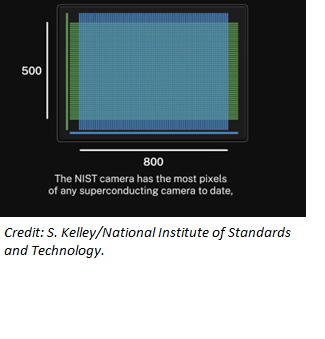 Researchers from the National Institute of Standards and Technology (NIST) and the National Aeronautics and Space Administration’s (NASA’s) Jet Propulsion Laboratory have built a superconducting camera containing 400,000 pixels – 400 times more than any other device of its type. Superconducting cameras allow scientists to capture very weak light signals, whether from distant objects in space or parts of the human brain. The NIST camera is made up of grids of superconducting nanowires, cooled to near absolute zero, in which current moves with no resistance until a wire is struck by a photon. Combining all the locations and intensities of all the photons makes up an image.
Researchers from the National Institute of Standards and Technology (NIST) and the National Aeronautics and Space Administration’s (NASA’s) Jet Propulsion Laboratory have built a superconducting camera containing 400,000 pixels – 400 times more than any other device of its type. Superconducting cameras allow scientists to capture very weak light signals, whether from distant objects in space or parts of the human brain. The NIST camera is made up of grids of superconducting nanowires, cooled to near absolute zero, in which current moves with no resistance until a wire is struck by a photon. Combining all the locations and intensities of all the photons makes up an image.
8) UC Irvine physicists discover first transformable nanoscale electronic devices
 Scientists from the University of California, Irvine, and the National Institute for Materials Science in Tsukuba in Japan, have reported the discovery of nanoscale devices that can transform into many different shapes and sizes even though they exist in solid states. What the scientists saw specifically was that tiny nanoscale gold wires could slide with very low friction on top of special crystals called van der Waals materials. Taking advantage of these slippery interfaces, they made electronic devices with single-atom-thick sheets of a substance called graphene attached to gold wires that can be transformed into a variety of different configurations on the fly.
Scientists from the University of California, Irvine, and the National Institute for Materials Science in Tsukuba in Japan, have reported the discovery of nanoscale devices that can transform into many different shapes and sizes even though they exist in solid states. What the scientists saw specifically was that tiny nanoscale gold wires could slide with very low friction on top of special crystals called van der Waals materials. Taking advantage of these slippery interfaces, they made electronic devices with single-atom-thick sheets of a substance called graphene attached to gold wires that can be transformed into a variety of different configurations on the fly.
7) Humidity may be the key to super-lubricity ‘switch’
 Researchers from Pennsylvania State University and Zhejiang University in China have proposed that super-lubricity – a state in which friction between two contacting surfaces nearly vanishes – may be found in water vapor and vapor in phenol (a family of organic compounds). The researchers used a silicon oxide probe on a surface of graphene to demonstrate how this might be possible. They found that super-low friction can be increased 25 times by water vapor and 45 times by phenol vapor.
Researchers from Pennsylvania State University and Zhejiang University in China have proposed that super-lubricity – a state in which friction between two contacting surfaces nearly vanishes – may be found in water vapor and vapor in phenol (a family of organic compounds). The researchers used a silicon oxide probe on a surface of graphene to demonstrate how this might be possible. They found that super-low friction can be increased 25 times by water vapor and 45 times by phenol vapor.
6) Designing with DNA
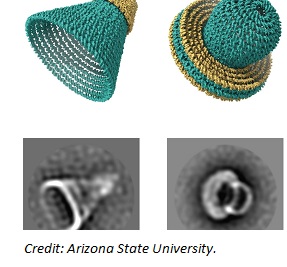 Researchers from Duke University and Arizona State University have created tiny nanoscale structures shaped like vases, bowls, and hollow spheres by using threadlike molecules of DNA. These creations demonstrate the possibilities of a new open-source software program developed by the researchers that lets users take drawings or digital models of rounded shapes and turn them into 3D structures made of DNA. The software could also allow researchers to create tiny containers to deliver drugs, as well as molds for casting metal nanoparticles with specific shapes for solar cells and medical imaging.
Researchers from Duke University and Arizona State University have created tiny nanoscale structures shaped like vases, bowls, and hollow spheres by using threadlike molecules of DNA. These creations demonstrate the possibilities of a new open-source software program developed by the researchers that lets users take drawings or digital models of rounded shapes and turn them into 3D structures made of DNA. The software could also allow researchers to create tiny containers to deliver drugs, as well as molds for casting metal nanoparticles with specific shapes for solar cells and medical imaging.
5) ‘Electronic nose’ built with sustainably sourced microbial nanowires could revolutionize health monitoring
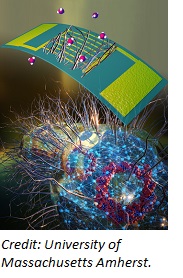 Scientists at the University of Massachusetts Amherst have invented a nanowire that can be cheaply grown by common bacteria and tuned to "smell" a vast array of chemical tracers – including those given off by people with different medical conditions, such as asthma and kidney disease. Thousands of these nanowires, each sniffing out a different chemical, can be layered onto tiny, wearable sensors, allowing health-care providers an unprecedented tool for monitoring potential health complications.
Scientists at the University of Massachusetts Amherst have invented a nanowire that can be cheaply grown by common bacteria and tuned to "smell" a vast array of chemical tracers – including those given off by people with different medical conditions, such as asthma and kidney disease. Thousands of these nanowires, each sniffing out a different chemical, can be layered onto tiny, wearable sensors, allowing health-care providers an unprecedented tool for monitoring potential health complications.
4) Nanobiotics: AI for discovering where and how nanoparticles bind with proteins
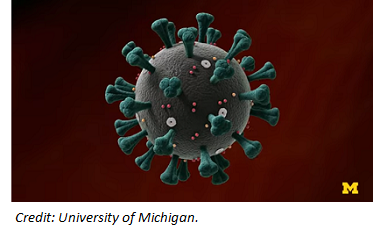 Researchers at the University of Michigan have developed a computer model that can identify whether and how nanoparticles and proteins bind with one another – an important step toward being able to design antibiotics and antivirals on demand. The new model uses machine learning—the AI technique that powers the virtual assistant on your smartphone and ChatGPT. But instead of learning to process language, it learns to extrapolate how proteins and nanoparticles might interact, predict binding sites and the likelihood of binding between them.
Researchers at the University of Michigan have developed a computer model that can identify whether and how nanoparticles and proteins bind with one another – an important step toward being able to design antibiotics and antivirals on demand. The new model uses machine learning—the AI technique that powers the virtual assistant on your smartphone and ChatGPT. But instead of learning to process language, it learns to extrapolate how proteins and nanoparticles might interact, predict binding sites and the likelihood of binding between them.
3) New laser-based method could help scientists discover puncture-resistant materials
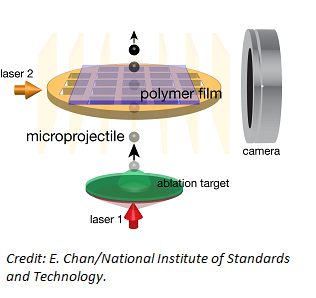 Researchers at the National Institute of Standards and Technology have designed a method that uses a high-intensity laser to blast microscale projectiles into a small sample at velocities that approach the speed of sound. The system analyzes the energy exchange between the microscale projectiles and the sample of interest at the micro level and then uses scaling methods to predict the puncture-resistance of the sample material against larger energetic projectiles, such as bullets encountered in real-world situations. The researchers used this new method to evaluate several materials, including a widely used compound for bulletproof glass, a novel nanocomposite, and the strong, all-carbon nanomaterial known as graphene.
Researchers at the National Institute of Standards and Technology have designed a method that uses a high-intensity laser to blast microscale projectiles into a small sample at velocities that approach the speed of sound. The system analyzes the energy exchange between the microscale projectiles and the sample of interest at the micro level and then uses scaling methods to predict the puncture-resistance of the sample material against larger energetic projectiles, such as bullets encountered in real-world situations. The researchers used this new method to evaluate several materials, including a widely used compound for bulletproof glass, a novel nanocomposite, and the strong, all-carbon nanomaterial known as graphene.
2) Bending 2D nanomaterial could ‘switch on’ future technologies
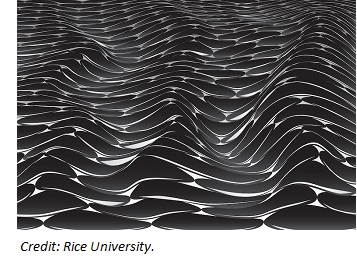 Scientists from Rice University and Taif University (Taif, Saudi Arabia) have uncovered a property of ferroelectric two-dimensional materials that could be exploited as a feature in future devices. They have shown that because they bend in response to an electrical stimulus, single-layer ferroelectric materials can be controlled to act as a nanoscale switch or even a motor. "The novelty we found in this study is that there is a connection or coupling between the ferroelectric state and the bending or flexing of the material,” said Boris Yakobson, one of the authors of the study.
Scientists from Rice University and Taif University (Taif, Saudi Arabia) have uncovered a property of ferroelectric two-dimensional materials that could be exploited as a feature in future devices. They have shown that because they bend in response to an electrical stimulus, single-layer ferroelectric materials can be controlled to act as a nanoscale switch or even a motor. "The novelty we found in this study is that there is a connection or coupling between the ferroelectric state and the bending or flexing of the material,” said Boris Yakobson, one of the authors of the study.
1) NIST Team Demonstrates Novel Way to Convert Heat to Electricity
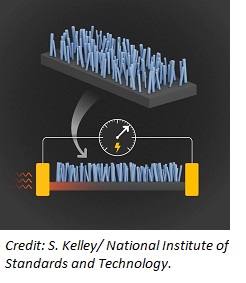 Researchers from the National Institute of Standards and Technology, the University of Colorado Boulder, and Beijing Institute of Technology have fabricated a novel device that could dramatically boost the conversion of heat into electricity. The new fabrication technique involves depositing hundreds of thousands of nanopillars of gallium nitride atop a silicon wafer. Layers of silicon are then removed from the underside of the wafer until only a thin sheet of the material remains. The interaction between the pillars and the silicon sheet slows the transport of heat in the silicon, enabling more of the heat to convert to electric current.
Researchers from the National Institute of Standards and Technology, the University of Colorado Boulder, and Beijing Institute of Technology have fabricated a novel device that could dramatically boost the conversion of heat into electricity. The new fabrication technique involves depositing hundreds of thousands of nanopillars of gallium nitride atop a silicon wafer. Layers of silicon are then removed from the underside of the wafer until only a thin sheet of the material remains. The interaction between the pillars and the silicon sheet slows the transport of heat in the silicon, enabling more of the heat to convert to electric current.


